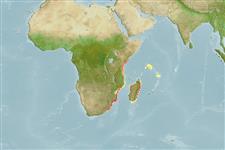Environment: milieu / climate zone / depth range / distribution range
Ecologia
marino associati a barriera corallina; distribuzione batimetrica 20 - 100 m (Ref. 4387). Subtropical
Western Indian Ocean: occurs only in Mozambique and Natal, South Africa.
Size / Peso / Age
Maturity: Lm ? range ? - ? cm
Max length : 60.0 cm TL maschio/sesso non determinato; (Ref. 4387); common length : 40.0 cm TL maschio/sesso non determinato; (Ref. 9660)
Spine dorsali (totale): 11; Raggi dorsali molli (totale): 20-24; Spine anali 3; Raggi anali molli: 14 - 17. Adults dark grey in color; juveniles yellow with black bars (very similar to young Diplodus cervinus hottentotus.
Occur in coastal rocky and coral reefs to a depth of 100 m; juveniles pelagic in currents (Ref. 4332). Benthic omnivores. May live longer than 10 years. Spawning occurs throughout the year (Ref. 57746). Marketed fresh (Ref. 9660).
Life cycle and mating behavior
Maturità | Riproduzione | Deposizione | Uova | Fecundity | Larve
Heemstra, P.C., 1986. Oplegnathidae. p. 632-633. In M.M. Smith and P.C. Heemstra (eds.) Smiths' sea fishes. Springer-Verlag, Berlin. (Ref. 4387)
IUCN Red List Status (Ref. 130435)
Threat to humans
Harmless
Human uses
Pesca: commerciale; Pesce da pesca sportiva: si
Informazioni ulteriori
Age/SizeAccrescimentoLength-weightLength-lengthLength-frequenciesMorfometriaMorfologiaLarveDinamica popolazioni larvaliReclutamentoAbbondanzaBRUVS
BibliografiaAcquacolturaProfilo di acquacolturaVarietàGeneticaElectrophoresesEreditarietàMalattieElaborazioneNutrientsMass conversion
CollaboratoriImmaginiStamps, Coins Misc.SuoniCiguateraVelocitàModalità di nuotoArea branchialeOtolithsCervelliVista
Strumenti
Special reports
Download XML
Fonti Internet
Estimates based on models
Preferred temperature (Ref.
123201): 23.6 - 26.7, mean 25.8 °C (based on 16 cells).
Phylogenetic diversity index (Ref.
82804): PD
50 = 0.5156 [Uniqueness, from 0.5 = low to 2.0 = high].
Bayesian length-weight: a=0.01995 (0.00906 - 0.04395), b=3.01 (2.83 - 3.19), in cm total length, based on all LWR estimates for this body shape (Ref.
93245).
Trophic level (Ref.
69278): 3.2 ±0.42 se; based on food items.
Resilienza (Ref.
120179): Basso, tempo minimo di raddoppiamento della popolazione 4.5 - 14 anni (tmax > 10).
Fishing Vulnerability (Ref.
59153): Moderate vulnerability (44 of 100).
